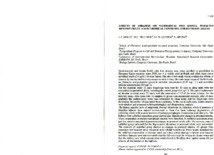Effects of atrazine on neotropical fish kidney, Piaractus mesopotamicus: a subchronical exposition and recovery assays.
Effects of atrazine on neotropical fish kidney, Piaractus mesopotamicus: a subchronical exposition and recovery assays.
Autoria: GIGLIO, E.; DELCORSO, M. C.; QUEIROZ, S. C. do N. de; ARANA, S.
Resumo: Environmental and human health risks that atrazine may cause justified its prohibition in European Union countries since 2005, but it is widely used in Brazil and often found above permitted levels (2.0 ?g/l-1) in river basins. The aim of this study was to evaluate the effects of atrazine by toxicity and recovery assays on trunk kidney, the main target organ of this herbicide, on Piaractus mesopotamicus (pacu) to sublethal concentration (3.57 mg / l-1) and non-lethal realistic concentration (3.0 ?g/l-1). For the exposure assay 12 pacu fingerlings were kept for 30 days in glass tanks with test concentrations presented above, including the control group (0.0 ?g/l-1). The partial replacement of atrazine occurred every 72 hours with the renovation of 1/3 of the water volume. For the recovery assay, other tanks with 12 samples by group were maintained similarly, after 30 days gradually the contaminated water was substituted by clean water and the fingerlings were maintained for another 14 days under these conditions. At the end of each assay, kidney samples were obtained and processed to histopathological and ultrastructural analysis. The kidney samples from all treatments showed Myxobolus sp. infection, which is common in Brazilian teleosts from natural environment or from fish farm, inducing degeneration of collecting tubule with massive reaction of melanomacrophages. Granulomas were also seen. The kidneys from sublethal exposition group showed also degenerative changes in proximal tubules, where no parasites or melanomacrophage reaction were identified. In nonlethal exposition group just few samples presented degenerative changes in proximal tubule cells. The recovery assay of sublethal group indicated that the degenerative alterations in proximal tubule were maintained. The recovery of nonlethal group showed no changes in proximal tubules. All groups from exposition and recovery assay presented renal tubular hyperplasia. These results indicated that the sublethal concentration of atrazine tested can induce serious damage to tubular renal function and those damages were not recovered when the fish were kept for 14 days in cleaner water and that the realistic non lethal concentration tested (found in Brazilian river basins) seems did not affect at all the function of the nephron.
Ano de publicação: 2015
Tipo de publicação: Resumo em anais e proceedings
Unidade: Embrapa Meio Ambiente
Palavras-chave: Atrazina, Piaractus mesopotamicus
Observações
1 - Por padrão são exibidas publicações dos últimos 20 anos. Para encontrar publicações mais antigas, configure o filtro ano de publicação, colocando o ano a partir do qual você deseja encontrar publicações. O filtro está na coluna da esquerda na busca acima.
2 - Para ler algumas publicações da Embrapa (apenas as que estão em formato ePub), é necessário ter, no celular ou computador, um desses softwares gratuitos. Sistemas Android: Google Play Livros; IOS: iBooks; Windows e Linux: software Calibre.
Acesse outras publicações
Acesse a Base de Dados da Pesquisa Agropecuária (BDPA) para consultar o acervo completo das bibliotecas da Embrapa.

